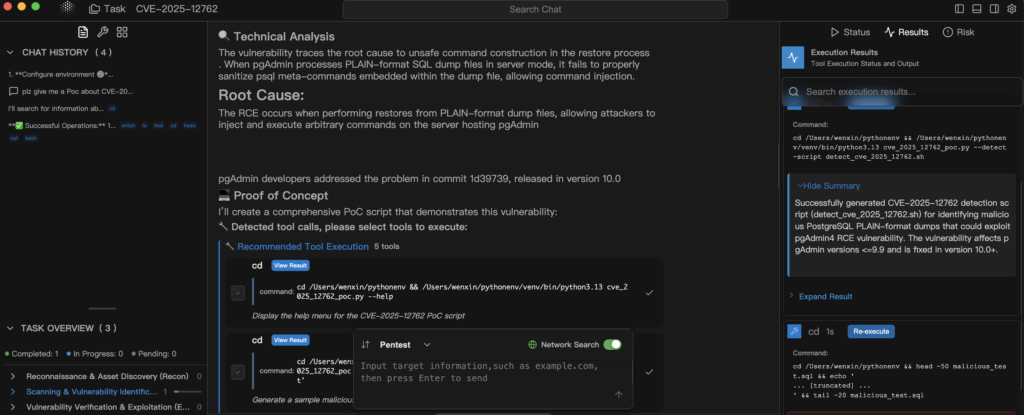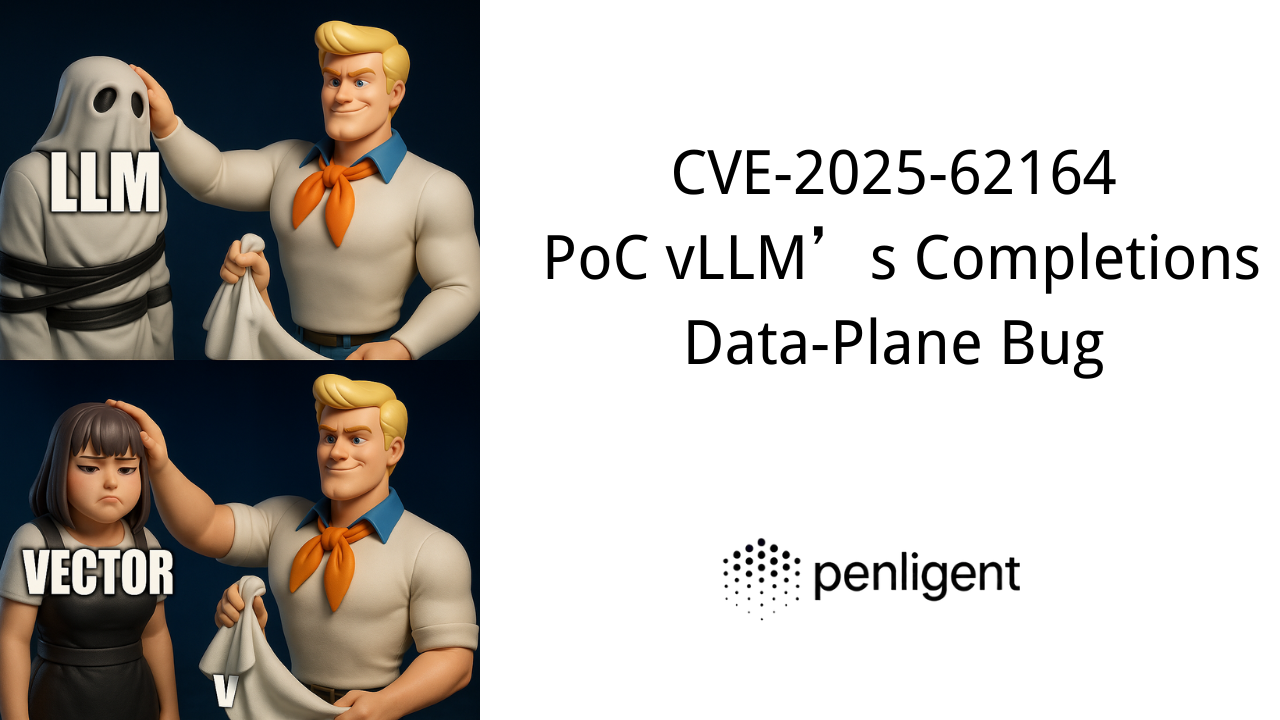CVE-2025-12762 is a critical remote code execution (RCE) vulnerability in pgAdmin 4 that turns a routine database restore into a potential server takeover. When pgAdmin is running in server mode and restores PLAIN-format PostgreSQL dump files, an attacker can abuse the restore pipeline to inject and execute arbitrary system commands on the host running pgAdmin. With a CVSS v3.1 score of 9.1 and pgAdmin’s position as one of the most widely used PostgreSQL administration tools, this is not a theoretical bug—it is a high-priority incident waiting to happen if left unpatched. (NVD)
What Is CVE-2025-12762?
CVE-2025-12762 affects pgAdmin 4 up to and including version 9.9 when the application is configured in server mode. In this mode, pgAdmin runs as a central web console used by DBAs, DevOps, and SRE teams to manage multiple PostgreSQL instances across environments. (OpenCVE)
The vulnerability triggers during restore operations using PLAIN-format SQL dump files. Instead of treating these dumps purely as SQL content, pgAdmin’s restore module in server mode processes the input in a way that allows attacker-controlled data from the dump to be incorporated into command execution. As a result, a malicious dump can lead directly to arbitrary code execution on the host where pgAdmin is running. (Cyber Security News)
The CVSS vector for CVE-2025-12762 is AV:N/AC:L/PR:L/UI:N/S:C/C:H/I:L/A:L, meaning the attack is network-based, low complexity, requires only low privileges, needs no user interaction, and can severely impact confidentiality while also impacting integrity and availability. (OpenCVE)

Affected Versions and Fixed Release
According to public advisories and vendor disclosures, pgAdmin 4 versions up to and including 9.9 are vulnerable when running in server mode and performing restores from PLAIN-format dump files. (NVD)
Security guidance and vulnerability feeds indicate that upgrading to pgAdmin 4 version 9.10 or later is necessary to fully address CVE-2025-12762. The updated release hardens the restore pipeline and removes the code injection path that made RCE possible in previous versions. (Proactive Insights)
Until that upgrade is completed, any pgAdmin instance that satisfies the following conditions should be assumed exposed:
- Running pgAdmin 4 ≤ 9.9
- Configured in server mode
- Performing or capable of performing restores from PLAIN-format PostgreSQL dump files
Root Cause: Code Injection During PLAIN Dump Restore
The root cause of CVE-2025-12762 is a code injection flaw inside the restore logic for PLAIN-format dumps in server mode. When pgAdmin orchestrates a restore, it builds command invocations for PostgreSQL utilities and passes along a combination of configuration, runtime parameters, and user-controlled values derived from the dump.
For PLAIN-format dumps, pgAdmin’s restore module incorrectly assumes that certain values derived from the dump are safe to pass into the restore command without strong validation and sanitization. Security research and advisories describe this as improper handling of code injection during server-mode restores from PLAIN-format dump files. (Cyber Security News)
In practice, this means:
- pgAdmin accepts a PLAIN-format SQL dump file.
- The restore module processes parts of the dump to construct or parameterize system-level restore commands.
- Because sanitization is insufficient, malicious payloads can break out of the intended argument context and be interpreted as actual commands on the host.
From the attacker’s perspective, the PLAIN dump becomes a vehicle for smuggling shell commands into the restore pipeline. Once the restore runs, these commands execute with the privileges of the pgAdmin process, which is often a powerful position inside a database or platform environment. (Dbugs)
Why This Vulnerability Is So Dangerous
Several characteristics make CVE-2025-12762 particularly dangerous for real-world deployments:
First, it is network reachable and requires only low privileges in pgAdmin. An attacker who can authenticate as a lower-tier user with restore permissions—or who has compromised such an account—can exploit the vulnerability without needing further elevation within the pgAdmin web UI. (CCB Safeonweb)
Second, the exploit path hides inside a legitimate operational workflow: restoring databases from dump files. Many organizations automate or semi-automate this workflow via runbooks, CI/CD jobs, or routine DBA tasks. This makes it easier for malicious payloads to blend in with expected activity, especially if monitoring is not focused around restore operations.
Third, the impact is host-level code execution. Successful exploitation doesn’t just corrupt a database; it can give the attacker a foothold on the underlying server, from where they can pivot to other systems, drop additional tools, harvest secrets, or tamper with backup and restore processes at scale. (siteguarding.com)
Realistic Attack Scenarios
Imagine a multi-tenant pgAdmin deployment where multiple teams share a central web console. A malicious or compromised user with basic restore privileges prepares a specially crafted PLAIN-format SQL dump. The dump renders as a normal backup file, but embeds payloads in a way tailored to the vulnerable restore module. Once the attacker uploads the dump and initiates a restore in pgAdmin, the payload triggers, executing arbitrary commands on the host.
Alternatively, think of a DevOps environment where database restores are integrated into CI/CD pipelines. An attacker who compromises a build agent or artifact store may substitute a legitimate dump with a weaponized PLAIN dump carrying the exploit. The next time the pipeline runs or a DBA uses that dump through pgAdmin, code execution occurs invisibly within what appears to be a normal restore step. (CCB Safeonweb)
In cloud or containerized environments, this could allow lateral movement between containers, credential theft for database or cloud APIs, or tampering with critical configuration that affects the integrity of multiple services.

Placeholder: Proof-of-Concept (PoC) for CVE-2025-12762
⚠️ This section is intentionally a placeholder. Replace it with your own lab-tested PoC when you publish, and always follow responsible disclosure and usage practices.
# PoC for CVE-2025-12762 (placeholder)
# -----------------------------------
# 1. Assumptions:
# - Vulnerable pgAdmin 4 (<= 9.9) running in server mode
# - Attacker has low-privileged account with restore permission
# 2. Malicious PLAIN-format dump:
# - Embed crafted content that causes command injection in restore pipeline
# 3. Exploitation:
# - Upload dump via pgAdmin UI
# - Trigger restore and observe arbitrary command execution on the host
# Insert your lab dump content and step-by-step PoC here.
# DO NOT target systems you do not own or explicitly control.
By keeping the PoC confined to a controlled environment (local VM, container, or dedicated lab), you can safely study the vulnerability’s impact without putting real data or infrastructure at risk.
How to Detect Possible Exploitation
Detecting exploitation of CVE-2025-12762 requires correlating restore events in pgAdmin with unusual system activity on the host.
On the host side, review logs from the OS, EDR, and process monitoring tools. Look for shell processes or commands that spawn in close temporal proximity to pgAdmin restore operations. Any unexpected invocations of shells, scripting interpreters, download utilities, or archive tools during a database restore should be treated as highly suspicious. (siteguarding.com)
On the pgAdmin side, inspect application logs to identify:
- Restore operations initiated by unusual users or service accounts
- Multiple restore attempts from the same user within a short window
- Restores from unexpected dump locations (e.g., temp upload directories, external shares, or user-supplied archives)
Correlating pgAdmin restore logs with host-level anomalies is often the best way to distinguish benign activity from an exploit chain abusing CVE-2025-12762.
Network telemetry and DNS logs can add another layer. If a restore event aligns with outbound connections to untrusted domains or IPs (for example, as part of a payload downloading second-stage tools), that is a strong indicator that restore was used as a backdoor rather than a routine maintenance operation. (Daily CyberSecurity)
Immediate Mitigation and Long-Term Hardening
The primary remediation for CVE-2025-12762 is clear: upgrade pgAdmin 4 to 9.10 or later. This removes the vulnerable behavior in the restore module and closes the direct RCE vector. (Proactive Insights)
Before the upgrade can be fully rolled out—or as a defense-in-depth measure—organizations should apply several additional controls:
First, harden access to server mode. Limit pgAdmin server-mode access to trusted networks or VPNs; enforce strong authentication and role-based access control; and reduce the number of users or service principals allowed to perform restore operations.
Second, treat PLAIN-format dumps as untrusted input. Even if they originate from “internal” sources, enforce controls such as checksum verification, signed artifacts, or controlled pipelines for generating and storing dump files. Where feasible, restrict restore workflows to formats and processes that are less exposed to user-controlled command construction. (Cyber Security News)
Third, apply host-level isolation. Run pgAdmin on hardened hosts or containers with reduced privileges and strong sandboxing (AppArmor, SELinux, systemd sandboxing, or container isolation). If exploitation occurs, these layers limit the blast radius and make lateral movement harder.
Finally, incorporate CVE-2025-12762 into your existing vulnerability management program: ensure it appears in internal advisories, scanning policies, and patch SLAs. Track exposure explicitly instead of relying on ad-hoc upgrades.
Using Penligent to Safely Reproduce and Validate CVE-2025-12762
For security teams and offensive security engineers, simply reading about CVE-2025-12762 is not enough. You often need to reproduce the issue, demonstrate impact to stakeholders, and validate that fixes are effective—without spending days handcrafting exploit payloads.
そこで 寡黙, an agentic AI pentest platform, can accelerate the workflow. Instead of manually writing the PoC from scratch, you can treat the vulnerability as a test case in a repeatable pipeline:
You start by defining a lab environment that mirrors your real pgAdmin deployment: same version (≤ 9.9), server-mode configuration, and similar network topology. Inside Penligent, you give the agent the CVE identifier (CVE-2025-12762) and high-level description—“RCE when restoring PLAIN-format PostgreSQL dump files in pgAdmin server mode.” The AI then chains tools to gather public technical details and synthesize a candidate PoC structure for a malicious PLAIN dump.
From there, Penligent can automatically generate a tailored PoC payload and a step-by-step execution plan, including how to upload and trigger the restore through pgAdmin’s web UI. Instead of blindly running code, you stay human-in-the-loop: reviewing the proposed payload, adjusting environment parameters, and confirming that the exploit only runs inside your controlled lab.
Once the exploit is validated, Penligent can help you turn the exercise into a regression test. After upgrading to pgAdmin 9.10+ or redesigning your restore workflow, you can re-run the same PoC scenario. If the exploit no longer yields code execution, the platform logs a successful mitigation. If it still works (for example, due to a misconfigured instance or a missed upgrade), Penligent flags the residual risk and helps you pinpoint which environment is still vulnerable.
By combining AI-generated PoC scaffolding with human oversight, Penligent lets teams move faster than opportunistic attackers—finding, weaponizing, and retiring vulnerabilities like CVE-2025-12762 in a structured and auditable way.
The Bigger Picture: Lessons for Database and AI-Driven Automation
CVE-2025-12762 is a reminder that administrative tooling is part of your attack surface, not just your convenience surface. pgAdmin 4 exists to make PostgreSQL administration simpler and more powerful, but complexity plus insufficient input validation can turn that power against you. (siteguarding.com)
The vulnerability also ties into a broader trend: as organizations adopt AI-driven automation—including AI copilots and agents that manage infra, databases, and security tooling—the number of layers converting “user intent” into “system commands” is exploding. Whether those layers live inside pgAdmin, an AI pentest agent, or a CI/CD system, they must all be designed under the assumption that:
- Backup files and configuration artifacts are not inherently trustworthy
- Any user-influenced data path into shell commands is a potential injection vector
- High-privilege automation should be treated as critical infrastructure
For database, security, and platform teams, the action items are therefore twofold. First, patch and harden: bring all pgAdmin instances to a fixed version, restrict server mode, and lock down restore workflows. Second, operationalize testing: use platforms like Penligent to continuously generate, run, and re-run exploit scenarios for critical CVEs, so that vulnerabilities like CVE-2025-12762 are caught, demonstrated, and eliminated before attackers can chain them into a real incident.


